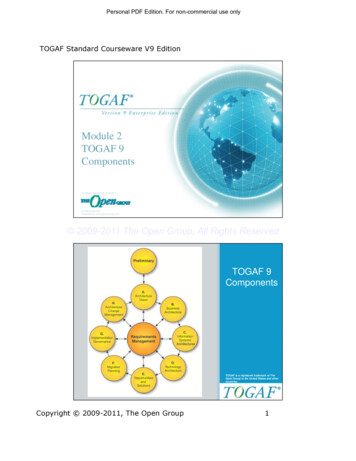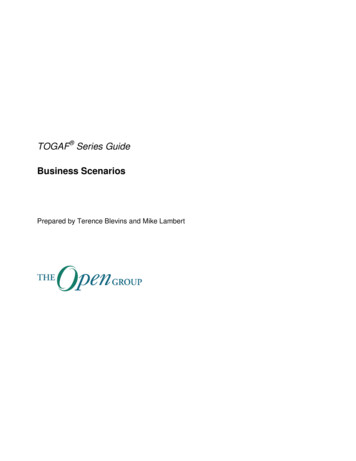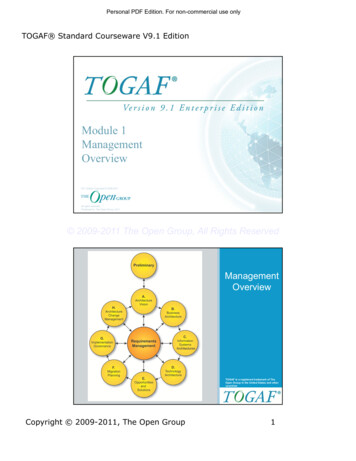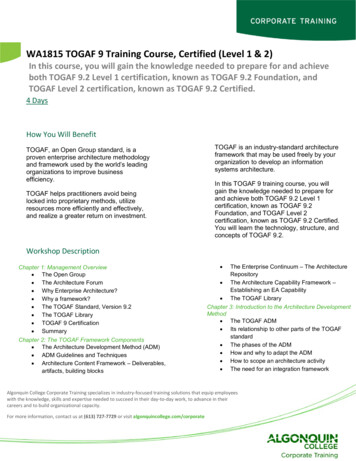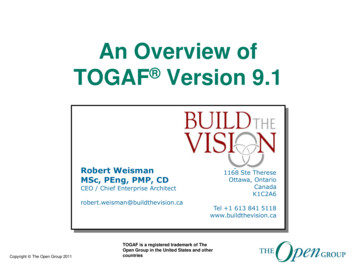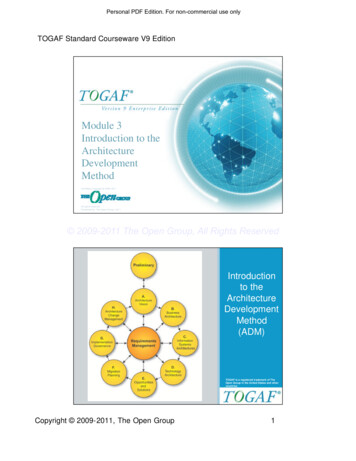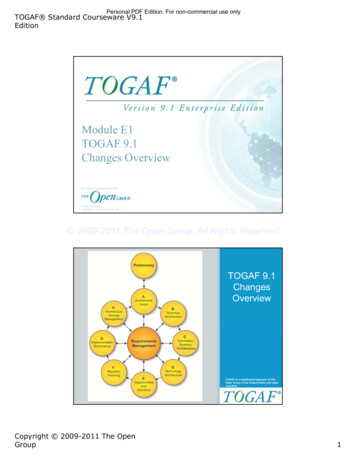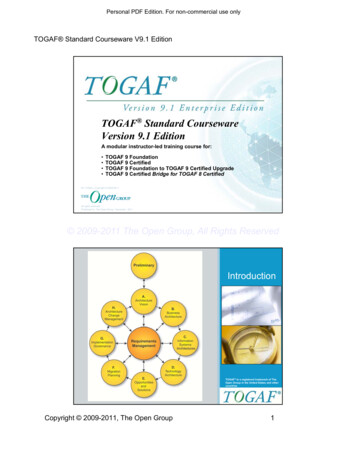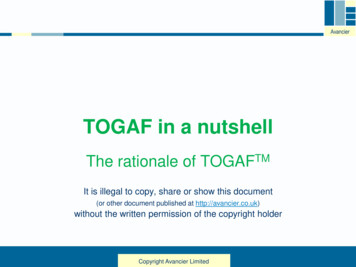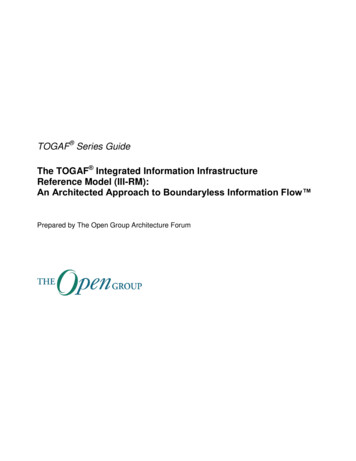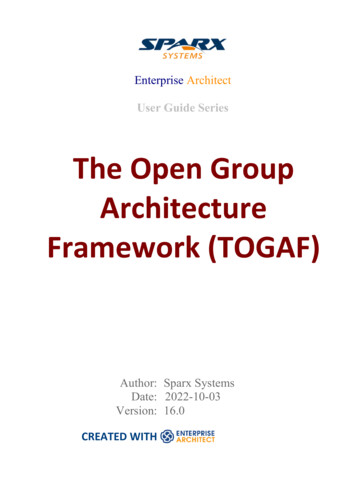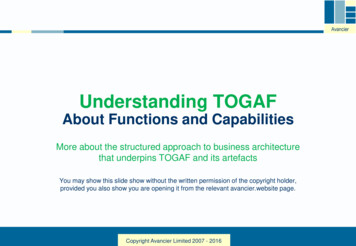
Transcription
AvancierUnderstanding TOGAFAbout Functions and CapabilitiesMore about the structured approach to business architecturethat underpins TOGAF and its artefactsYou may show this slide show without the written permission of the copyright holder,provided you also show you are opening it from the relevant avancier.website page.Copyright Avancier Limited 2007 - 2016
The TOGAF content framework is not currently consistentAvancierOrganisation decompositionOrg/Function matrixOrganization/Actor catalogueFunctional decompositionBusiness Function/Service catalogueActor/Role matrixRole catalogueProcess flow diagramBusiness Scenario(Surely to Role, not Actor?)Process/Event/Control/Product catalogueProcess/Event/Control/Product catalogueProcess/Event/Control/Product cataloguePrinciples: If anassociation appears inan artifact, it is acandidate for the metamodel.Data Entity/BusinessFunction matrixBusiness Service/Product catalogueIf an association doesnot appear in anartifact, it is a candidatefor removal.The important Function is bounded by Service association does not feature in the SOA chapter.The important Process realises Service association is not represented in an Artefact.The Org/Function matrix (important to structured analysis) is mentioned in the text, and reflected in the meta model, but does not appear in an Artefact.The meta model lacks the Data Entity-Function association represented in an Artefact.The meta model lacks the Service-Product association represented in an Artefact.Actors and Organisation Units are distinct entities in the meta model, yet Actors are defined as including Organisation Units.AvancierLimited2012 or Role.Actors being individuals, several associations to Org UnitCopyrightor Actor wouldbe betterto Function
How TOGAF’s artifacts document a Business ArchitectureDriverPrinciples catalogueDriver/goal/objective catalogue!PrincipleGoalBusiness Function/Service catalogueRequirementBusiness Service/Product uct catalogueFunctional decompositionAtomicBusinessActivityData EntityOrg. Function matrixBusiness Interaction matrixFunctionProcessProcess flow diagramOrganisation decompositionOrg UnitData Entity catalogueData Entity/BusinessFunction matrixAvancierOrganization/Actor catalogueIS (App)ServiceRoleRole catalogueActorActor/Role matrixCopyright Avancier Limited 2007 - 2016
TOGAF suggests 3 approaches to Business ArchitectureAvancierDriver!Principle“The level and rigor of decomposition neededvaries from enterprise to enterprise”GoalRequirementProcess ModellingDefine high-level Processes/ScenariosDecompose Processes to activitiesMap activities to Roles & essActivityData EntityIS (App)ServiceStructured Analysis“Identifies the key business Functionswithin the scope of the architecture, andmaps those Functions onto theOrg units within the business.”Org UnitRoleUse-case AnalysisIdentifies where Roles use Applications inperforming Process steps, and defines therequired IS (App) ServicesCopyright Avancier Limited 2007 - 2016Actor
TOGAF PrinciplesAvancier Principles that underpin Structured Analysis, TOGAF and its artefacts,and relate Functions to Capabilities1. Functions are independent of Organisation structure (8.4.1, 8.5).2. Functions impose a structure on Activities sequenceable in Processes(34.2.1).3. Functions/Capabilities are defined by Services provided (35.6.3)4. Functions are used to describe Capabilities (34.2.1).Copyright Avancier Limited 2007 - 2016
1) Functions are independent of Organisation structure Structured Analysis “Identifies the key business Functions within the scope of the architecture,and maps those Functions onto the Org units within the business.” (8.4.1) Business architecture outputs include “Correlation of Organization and Functions — relate business Functions toOrganizational units in the form of a matrix report.” (8.5) Organization Unit: “A self-contained unit of resources with goals, objectives, and measures.”(34.2.1) 1 Function/Capability may be mapped to 1 Org Unit, several Org Units,or parts of several. Those Org Units inherit some or all of any target qualities given toFunctions/Capabilities.Copyright Avancier Limited 2012Avancier
2) Functions impose a structure on Activities sequenceable inProcessesAvancierAtomic activities in Business le Claim ProcessEmailApprovalPay ClaimAtomicActivityMay be placed at the bottom of the Functional DecompositionArchiSurance: Function Hierarchy / Capability MapA strict (non-redundant) hierarchy.Claim HandlingCustomer laimProduct onCopyright Avancier Limited 2012LegalComplianceMaintainclientrecords
Theory and practiceAvancierIn theory, every atomic activity in a Process can be placed at the bottom of aFunctional decomposition hierarchy (34.2.1).FunctionProcessProcess flowdiagramAtomicActivityFunctionaldecompositionIn practice The Function hierarchy usually stops at a high (3rd or 4th) level Some Process models descend to a lower (5th or 6th) level.Copyright Avancier Limited 2012
3) Functions/Capabilities are defined by Services provided “The purpose of the Business Service/Function catalog is toprovide a Functional decomposition [It] can be used to identifyCapabilities of an Organization . “(35.6.3)BusinessServiceBusiness Function/Service catalogueFunctional decompositionCorrelation of Organizationand Functions in a matrixFunctionProcessAvancierAtomicActivityOrg Unit Business architecture outputs (8.5) include “Business Functions — a detailed, recursive step involving successivedecomposition of major Functional areas into sub-Functions.” “Correlation of Organization and Functions — relate businessFunctions to Organizational units in the form of a matrix report.”Copyright Avancier Limited 2012
Capabilities as Functions Function describes units of business Capability at all levels ofgranularity (TOGAF 34.2.1) Capabilities are typically expressed in general and high-level termsand typically require a combination of Organization, people,Processes, and technology to achieve. For example, marketing,customer contact, or outbound telemarketing. [cf. Function Names](TOGAF 3.26) This Functional decomposition can be used to identify newCapabilities required to support business change. The purpose of the Functional Decomposition diagram is to showon a single page the Capabilities of an Organization . (TOGAF35.6.3) Implication: Functions have all the attributes Capabilities have including target qualitiesCopyright Avancier Limited 2007 - 2016Avancier
Capability-Based PlanningAvancier Chapter 32 on Capability-Based Planning has 10 (ten!) referencesto Capabilities being cross-organisational. It not about improving an Organisation Unit It is about improving a named Function (say, HR) regardless ofwhere it is carried out in the Organisation Both Structured Analysis and CBP encourage architects to discuss Functions/Capabilities independently of Org Units. examine business objectives, services and processes beforemapping those to Organisation Units.“Function describes units of business Capabilityat all levels of granularity” TOGAF 34.2.1Capability ViewOrganisation ViewFunctional decompositionOrganisation decompositionFunctionRoleRole catalogueCopyright Avancier Limited 2007 - 2016Org/FunctionmatrixActor/RolematrixOrganisation UnitOrganization/ActorcatalogueActor (human)
Hmm Avancier EA is about human and computer activity systems in whichActors/components achieve desired effects by playing Roles in Processes. A required Capability (say Sales, or Disaster Recovery) can be specifiedas a group of required products or Services resulting from Processes performed by Actors/components A required Function (say Sales, or Disaster Recovery) can be specified asa group of required products or Services resulting from Processes performed by Actors/componentsCopyright Avancier Limited 2007 - 2016
Capability Function Target Qualities Resources Needed A Capability is a view rooted in a Function (at whatever level of granularity AtomicBusinessActivityData EntityIS (App)ServiceIt can encompassas many of theremaining entitiesas you chooseCapabilityEntryPointOrg UnitRoleApplicat’nTechnol’gyCopyright Avancier Limited 2007 - 2016ActorAvancier
So, Capability Function In business architecture documentation Capability (say Marketing) Function (Marketing) quality targets resources neededCopyright Avancier Limited 2007 - 2016Avancier
Reader’s challenge 1: What makes Disaster Handling a Capability? An enterprise may not formalise disaster handling It may rely on the ad hoc responses of intelligent human Actors when a disasterhappens. It may do little or nothing other than encourage Actors to think about disasters and whatthey can do about them. Or, it may set out to develop a disaster handling Capability Which is to formalise and systemise Nominate a DR FunctionDefine what kinds of disaster are to be anticipatedDefine targets for recovery from those disastersDefine Roles and Processes needed to achieve DRAcquire resources (Actors, components etc.) needed perform DR Roles and ProcessesTestingEtc.Copyright Avancier Limited 2007 - 2016Avancier
Reader’s challenge 2: What makes Innovation a Capability? You may perceive an enterprise as being innovative But so far, innovations have been down to human inspiration andmotivation to follow them up. How to develop a tangible innovation “Capability”? The EA concept of Capability implies a degree of systemisation Nominate an innovation FunctionDefine where innovation is soughtDefine targets for innovation success (e.g. income from new products)Define Roles (if not Processes) needed to achieve innovationAcquire resources (Actors) needed perform the Roles and ProcessesEtc.Copyright Avancier Limited 2007 - 2016Avancier
Capability Function Target Qualities Resources Needed Variations of "Capability" appear in “Capability maturity models” and“Capability based planning”, and in TOGAF (with various meanings) DoDAF is built around Capability-based planning. It does not have theconcept of a business Function, because Capability takes its place. Some Capabilities may correspond to a Function in a primary business-asusual Functional decomposition hierarchy (usually but not inevitably a highlevel Function). Other Capabilities (e.g. “Disaster Handling”) might not appear in theprimary Function hierarchy. But you can define other Function hierarchies. And you can define a Function independently of any hierarchicaldecomposition structure, as a free-standing structural component, agrouping of any activities you choose. So, whether your Capability is named in a Function hierarchy or not, it isalways representable as a Function target qualities resources needed.Copyright Avancier Limited 2007 - 2016Avancier
AvancierAvancier MethodsAbstracting a meta from EA artefactsBased on the structured approach to business architecturethat underpins TOGAF and its artefactsYou may show this slide show without the written permission of the copyright holder,provided you also show you are opening it from the relevant avancier.website page.Copyright Avancier Limited 2007 - 2016
How TOGAF documents a business activity systemIf an association does not appear in an artifact, remove it (or else find an artefact).Principles catalogueDriver/goal/objective catalogueArchitecture Requirements SpecE.g. which TOGAF productsrecord these two associations?Data/Info ViewService ViewData EntityEventProcess/Event/Control/Product catalogueProductCapability ViewOrganisation ViewFunctional decompositionOrganisation decompositionData Entity/BusinessFunction matrixBusiness Service/Product catalogueBusiness ServiceAvancierBusiness Function/Service catalogueFunctionOrg/FunctionmatrixFunctional decompositionProcessProcess flowdiagramAtomic ActivityBusinessScenarioRoleRole catalogueProcess ViewIS (App) ServicePeople ViewApplicationTechnologyIS/IT ViewCopyright Avancier Limited 2007 - 2016Actor/RolematrixOrganisation UnitOrganization/ActorcatalogueActor (human)
Skills Framework for the Information Age suggests 7 views of EA The Views can be centred on the Atomic Business ActivitiesEnvironmentRequirementExternal environsBusinessServiceBusinessService viewProcess viewOrganisation viewAtomicBusinessActivityData EntityDataFunctionProcessOrg UnitData/Info viewIS (App)ServiceRoleActorTechnology viewApplicat’nApps &TechnologyPeople viewTechnol’gyCopyright Avancier Limited 2007 - 2016Avancier
Designing activity systemsAvancier Define required Services, and Processes to deliver them Assign activities in Processes to Functions and Roles Find Org units and Actors to perform the activities when requiredPassivestructureacted onAssigned toRequiredLogical activebehaviour elementsstructure elementstriggered by events, produce resultsgroup activity typesBusinessServiceBusiness/FunctionService cat.FunctionalDecompositionProcessBusinessProcess FlowdiagramFunctionBusinessActivityRoleRole catalogueRealised byOrg cal activestructure elementsperform activitiesOrg UnitOrganisationStructureActorData Entity/BusinessFunction matrixInformationSystemsData EntityIS (App)ServiceIS ServicecatalogueUse ionPortfolio CatApplicationPortfolio CatCopyright Avancier Limited 2007 - 2016
Design sequences used in EAAvancierFunction: externally, a group of service types; internally, a group of activity typesRole: externally, a group of service types; internally, a group of activity typesRequiredBehaviourAssigned toLogicalStructureRealised nctionOrg UnitBusinessProcessRoleActorDataData ModelData StoreApplicationsIS tionCopyright Avancier Limited 2007 - 2016LocationNothing is reallyphysical in EA, butwhen implemented,a physical elementmust beaddressable
Core artifacts: describe architectural entities and relations between them2 Context / PrecursorsDriver/Goal/Objectives cat.Principles catalogueStakeholder catalogueRequirements catalogueBusiness Scenario diagramSolution Vision diagram4 Business ArchitectureBusiness Function/Service catalogueFunctional Decomposition diagramOrganisation/Function matrixOrganization/Actor structureActor/Role matrixProcess catalogueProcess Map diagramProcess Flow diagramRole/Information Service catalogue7 Applications ArchitectureInformation Services catalogueApplication Portfolio catalogueData Flow catalogueApplication/Data Entity matrixApplication/Function matrixApplication Communication diagramApplication Use Case diagramApplication Platform Service catalogue5 Data ArchitectureData Entity catalogueData Entity/Business Function matrixData Store catalogueLogical Data Model diagramData Dissemination diagramCRUD diagram9 Infrastructure (Tech) ArchitectureTechnical Reference ModelTechnology Standards catalogueTechnology Portfolio catalogueApplication Technologies diagramDeployment diagramNetworked Computing Hardware diagramCommunications Engineering diagramCopyright Avancier Limited 2007 - 2016Avancier10 Migration PlanningRAID catalogueValue/Cost/Risk GridMigration PathRoad Map
Abstracting a meta model from the al decompositiondiagramObjectivePrinciples catalogueRequirementRequirements catalogueProcess Map diagramBusiness Function/ServicecatalogueGoalPrincipleProcess catalogueAvancierOrganisation/Function matrixOrganisation/Actor structureBusinessBusinessServiceFunctionOrg UnitRole /Info Service catalogueProcess Flow diagramData Entity/BusinessFunction matrixActor/Role matrixProcessRoleActorData Store catalogueLogical Data ModelData Entity catalogueData / InformationData EntityData StoreData Dissemination matrixUse Case diagramI/O Data FlowsInfo Services catalogueInfo. ServiceApplication Platform ServicecatalogueApplicationsTechnical Reference ation Portfolio terfacePlatformApplicationCopyright Avancier Limited 2007 - 2016Data Flow catalogueApplication/Data Entity matrixApplication/Function matrixApplication Communication diagramTechnology Portfolio catalogue
cyObjectiveRuleRequirementMissionAM meta modelVision As complete asseems reasonableStakeholderConcernAssigned toRealised byBusinessOutputBusinessServiceFunctionOrg UnitLocationRuleProcessRoleActorData EntityData StoreIS mServicePlatformInterfaceInputData / ight Avancier Limited 2007 - 2016NodePlatformApplication
Methods and resources at http://avancier.website Avancier Methods areuseful with all architectureframeworks that sharesimilar ends and meansAvancierBCS E&SAreference modelArchiMateLanguageFrameworkTOGAFThe Open GroupAvancierMethodsCSC’s domains ofchange (POLDAT)IBM’s view EAEA as Strategy”MITCopyright Avancier Limited 2007 - 2016
TOGAF Principles Principles that underpin Structured Analysis, TOGAF and its artefacts, and relate Functions to Capabilities 1. Functions are independent of Organisation structure (8.4.1, 8.5). 2. Functions impose a structure on Activities sequenceable in Processes (34.2.1). 3. Functions/
